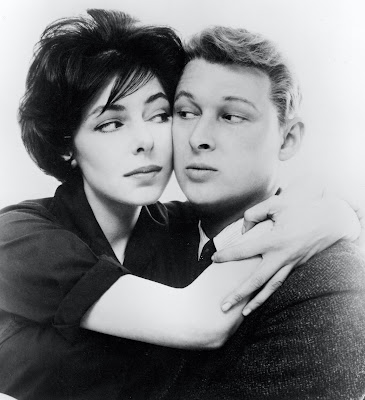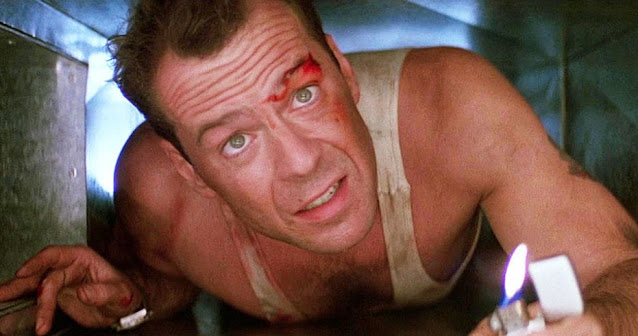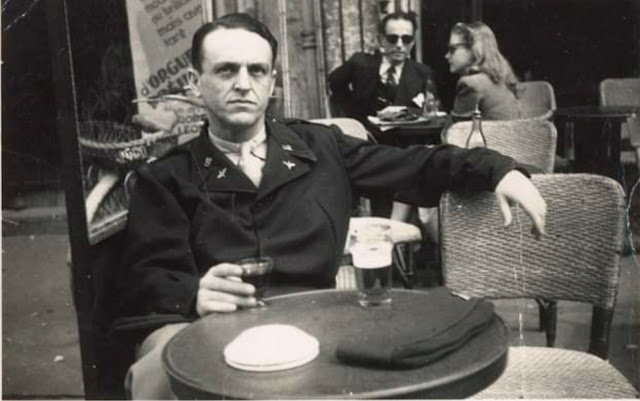Nichols & May, Together Again for "The Birdcage"
Mike Nichols was born Michael Igor Peschkowsky in 1931 in Berlin. His Jewish parents were forced to flee Germany to escape the Nazis in 1939, and settled in the United States. While attending the University of Chicago in the 1950s, he had a fateful meeting with Elaine May.
 |
| Improv comedy partners Elaine May and Mike Nichols |
Elaine May was born Elaine Berlin in Philadelphia in 1932, the daughter of theater director and actor Jack Berlin and actress Ida Aaron Berlin. As a child, May occasionally performed with her father in the Yiddish theater he ran. She married Marvin May in the late ‘40s, while still a teenager, and gave birth to a daughter in 1949. The following year, May started attending classes at the University of Chicago.
For both Nichols and May, the pivotal event of their careers was their chance meeting in a train station in the spring of 1954. “Elaine May and I met at the University of Chicago,” said Nichols. “My first impression of her was of a beautiful and dangerous girl that interested me enormously, and scared me. We were both what was known on campus as ‘dangerous.’ We were introduced, and then we oddly met again in the railway station on the way back to the South Side of Chicago, where the university was. I said, ‘May I sit down?’ and she said, ‘Eeef you wish,’ and just like that, we were in an improvisation – we did a whole long spy mystery improvisation for the benefit of the other people on the bench. That’s how we met… and then we were friends. We did it later on one of the records, but we improvised it in the actual railroad station the first time, before we knew each other.”
 |
| Elaine May and Mike Nichols in New York City in 1961 |
After graduation, Nichols left Chicago to study acting with Lee Strasberg in New York, but he soon returned to Chicago, where May was working with director Paul Sills and others in developing improvisational comedy at the Compass. “The Compass was what became Second City,” said Nichols. “The idea was that it would be improvised, and there wasn’t much of an idea after that, so there were weeks of desperation onstage. What was nice about the Compass was that we were very near the lake, and when something went really badly wrong, you could just run out back and jump in the lake.”
“Chicago is not a very fashion-driven place,” Nichols said. “Nobody says, ‘Oh, you’ve got to come see these fabulous people!’ Nobody cares. You know, they come and they laugh and then they go home. They’re not impressed with anything, which is the best possible training for anybody… As Elaine says, ‘It wasn’t such a big deal in Chicago.’”
Nichols and May developed new, reality-based takes on sex and relationships, and based their improv characters on themselves and the people they knew. By 1957, when they took their act to New York, nightclubs and TV, they had perfected it. “I guess it’s not dissimilar to jazz,” said Nichols. “Now and then you get hot, and you don’t know why, and it mostly consists of looking into your partner’s eyes and thinking, ‘Oh my God! I know what you’re going to do, and when you get there, I’ll be there, too!’”
 |
| Comedy duo Nichols & May took Broadway by storm with An Evening with Mike Nichols and Elaine May in 1960 |
Dubbed “the world’s fastest humans” for their dry, whip-smart dialogue and lighting-fast improv, Nichols & May were enormously popular. “The nice thing was to make an audience laugh and laugh and laugh, and shudder later,” said May. In 1960, Nichols and May hit Broadway with their revue, An Evening with Mike Nichols and Elaine May, which ran for a year before the two decided to go their separate ways.
After his breakup with May, Nichols was in despair. His breakthrough, he said, came with a phone call from a producer who asked him if he wanted to direct a play. It was written by Neil Simon, and would later be called Barefoot in the Park. “I mean, those were the days,” said Nichols. “I said, ‘I’d like that guy I saw on Playhouse 90 last night’ – it was Redford. On the first day of rehearsal, I thought, ‘Well, look at this. Here is what I was meant to do.’ I knew instantly that I was home.” He went on to his film directing debut with 1966’s Who’s Afraid of Virginia Woolf? and followed it up the next year with the instant classic The Graduate, which led to many more critically lauded films.
 |
| Mike Nichols directing Elizabeth Taylor, George Segal and Richard Burton on the set of Who's Afraid of Virginia Woolf? in 1966 |
Elaine May also became a director, but with less success than Nichols. She made her film writing and directing debut in 1971 with A New Leaf, a screwball comedy starring herself and Walter Matthau. Her second movie as director was 1972’s The Heartbreak Kid. Critically lauded and mildly successful, it was based on a screenplay by Neil Simon. May followed up these two comedies with a bleak, almost completely improvised crime story entitled Mikey and Nicky in 1976. After that, she co-wrote 1978’s Heaven Can Wait with Warren Beatty, garnering herself an Oscar nomination.
However, May’s directing career would crash to a halt with her next directorial effort, 1987’s infamous Ishtar. Largely shot on location in Morocco, the production was beset by internal difficulties – going over budget to the tune of $30 million – and advance publicity was so negative that the picture became one of the biggest box-office failures of its time. “Ishtar” has since become synonymous with “box office flop.” Nonetheless, in retrospect many consider the film to be unfairly maligned.
 |
| Elaine May directing Ishtar in 1987 |
Elaine May has long been a highly-paid script doctor, and according to rumor, has ‘script doctored’ each of Mike Nichols’ movies since they reconciled in the ‘70s. They got back together officially in the mid-'90s, when May saved Nichols’ script for Wolf, a film which he had almost quit in despair. After May agreed to come out into the open as the screenwriter of The Birdcage, she collaborated with Nichols once more, on the Oscar-nominated screenplay for 1998’s Primary Colors.
“Elaine had a great rule,” said Nichols. “‘When in doubt, seduce. It’s a great rule for life, too.’”
Robert Rice, “Profiles,” New Yorker, 4/15/61
Gavin Smith, “Mike Nichols,” Film Comment, 5/1/99
Elaine May, The Birdcage: The Shooting Script, Newmarket Press, 1997
Phil Rosenthal, “Improv Duo Paved the Way,” Chicago Sun-Times, 3/6/00
Peter Marks, “Mike Nichols Honors Graduate,” Washington Post, 12/7/03


Comments